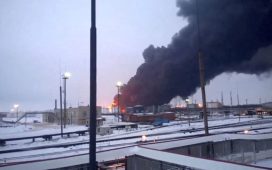Just when I thought things could not get worse with this Texas mess, they do. Nearly 3 million people are still without power as of 6:30 am on February 17th, 2020 according to the Poweroutage.us. Numerous media outlets are reporting that the Galveston County Medical Examiner office has attempted to secure refrigerated trucks for human bodies. Like COVID-19, Hurricane Harvey, or Superstorm Sandy, we saw the magnitude of this extreme weather event coming days to weeks in advance so how is it that millions of people in an affluent state are left to suffer? It is a classic mix of planning, infrastructure cost, extreme weather probability, bad luck and other factors. However, it is a song we’ve heard many times before with extreme weather and compound events.

FORT WORTH, TX – FEBRUARY 16: Pike Electric service trucks line up after a snow storm on February … [+]
Getty Images
A family may debate whether to buy flood insurance or extra warranty coverage on new 85 inch television set. There is a “risk versus cost” calculus that plays out in such decisions. According to experts, this same situation is revealing itself on a larger scale. My Forbes colleague Joshua Rhodes is an energy researcher at the University of Texas. On Valentine’s Day, he wrote, “Usually The Electric Reliability Council of Texas (ERCOT, the electric grid that serves 90% of Texas electricity demand) gets attention in the dog days of summer when temperatures soar above 100 degrees F, air conditioners work round-the-clock to keep us cool, and the grid strains to keep up.” This time around crippling cold temperatures, freezing rain, and snow brought the system down.
In a recent (and highly recommended) Twitter thread, Rhodes went on to say that energy supply and demand are extremely out of balance because of the anomalously cold temperatures. While many renewable energy naysayers or climate change contrarians were quick to jump on the “see we told you green energy was not reliable” bandwagon, Politifact quickly debunked that politically-motivated talking point. Rhodes noted that there have been some wind farm issues with icing but tweeted, “There were about ~14GW of power plants that were down for maintenance before this event started.” According to Rhodes, another 16GW of power went down during this extreme cold event so there was increased demand for heat, which caused gas to be diverted from power plants to homes. Additionally, some gas wells froze. The bottom line (high school economics flashback) is that this is a “supply – demand” disaster on steroids.

ADRIAN TX – APRIL2: Wind power in Texas consists of many wind farms with a total installed nameplate … [+]
Getty Images
However, I want to focus on one of Rhodes’ final point in his Tweet thread. He tweeted in response to a question about what to do going forward that, “We can update our winter peak resource adequacy assumptions to better reflect weather like this and make sure that we have the proper market mechanisms to incentivize generation (and required fuel) additions that meet those requirements.” I will let Dr. Rhodes handle the last part in his writing, but the first part of the Tweet sounds very familiar to me as a meteorologist and climate scientist. In a 2014 government report the authors warned of our increasing infrastructure vulnerabilities to extreme weather. I also opined in 2019 that, “Infrastructure….an area where there is likely potential room for bipartisan collaboration in the political world. Everyone recognizes the importance of roads, bridges, electrical grids, railways, and buildings.”
Ian Giammanaco is lead research meteorologist and senior director for product design at the Insurance Institute for Business and Home Safety. He said, “The occurrence probability versus cost, this is an age old question we deal with all the time with extreme weather (including in his work related to extreme winds and the insurance industry).” The following questions about infrastructure versus what are perceived to be low-probability events makes the point:
- Does it make sense for the city of Atlanta to invest in a large fleet of salt trucks when it receives minimal snowfall each year?
- Does a new office complex in a hurricane-prone region spend additional resources to withstand Category 4 wind rather than Category 3 winds?
- Should we invest in better weather prediction resources before they happen rather than in a knee-jerk reaction as we saw after Superstorm Sandy or Hurricane Harvey.
The scientific literature is clear that we are likely to increasingly face more intense hurricanes, sustained heatwaves, extreme cold, and flooding. S&P Global also agrees. In a blog post on its website, Gabe Grosberg writes, “As our climate continues to change, effective management of weather-related risks is becoming more complex and ever more important, especially as it relates to the credit quality of regulated utilities in North America.” He goes on to say, “Adverse weather events are forcing utilities to look at ways to protect their assets from natural disasters and maintain their investment-grade credit quality.”
There are many factors at play with the current mess in Texas so do not fall for the motivated reasoning on certain news media and social media platforms. Since we are a reactive society, let’s learn from this event and take the long view. As I have said repeatedly in my world of risk assessment for weather, the prediction models are too good these days to have “hope” or “let’s wait and see” as your risk mitigation strategy. Proactive planning is critical and potentially life-saving. Giammanco sums it nicely – “Being proactive with resilience has shown even a 10 to 1 return on reducing losses from catastrophic events. One day we’ll get this right.”

GALVESTON, TEXAS – OCTOBER 09: A man walks down the walkway at the 61st Street Fishing Pier at … [+]
Getty Images








